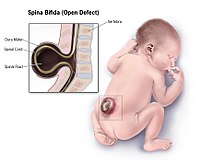
Photo from wikipedia
The term spinal dysraphism defines an incomplete fusion or a bone defect that affects the neural structures of the spinal cord due to a neural tube malformation. A 6-month-old, male,… Click to show full abstract
The term spinal dysraphism defines an incomplete fusion or a bone defect that affects the neural structures of the spinal cord due to a neural tube malformation. A 6-month-old, male, mixed-breed dog, was evaluated for paraparesis, pelvic limb proprioceptive ataxia, faecal and urinary incontinence. A neurological examination indicated an L4-S3 spinal cord segment lesion. A thoracolumbar and lumbosacral spine magnetic resonance imaging was performed and a closed spinal dysraphism, with the presence of a lipomyelomeningocele, was detected. The magnetic resonance imaging showed an entire narrowing passage and a fibrous mass stemming from a wedgeshaped gap in the caudal region of the dorsal lamina of the L4 vertebra, leaving the spinal canal towards the skin surface in the region where the skin stigma was observed. A dorsal laminectomy was performed, the spinal cord was exposed, and the entire fibrous mass was excised. Three months postoperatively, the patient had a complete resolution of the urinary and faecal incontinence showing only a residual mild paraparesis, which remained six months after surgery. The surgical procedure resulted in the satisfactory recovery of the neurological signs.
Journal Title: Veterinarni Medicina
Year Published: 2021
Link to full text (if available)
Share on Social Media: Sign Up to like & get
recommendations!